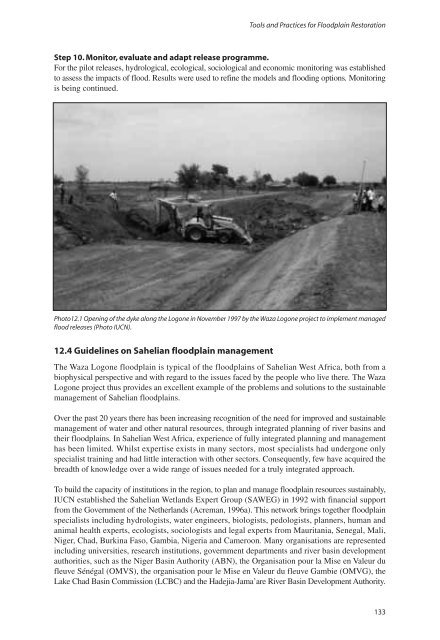The return of the water - IUCN
The return of the water - IUCN
The return of the water - IUCN
You also want an ePaper? Increase the reach of your titles
YUMPU automatically turns print PDFs into web optimized ePapers that Google loves.
Step 10. Monitor, evaluate and adapt release programme.<br />
For <strong>the</strong> pilot releases, hydrological, ecological, sociological and economic monitoring was established<br />
to assess <strong>the</strong> impacts <strong>of</strong> flood. Results were used to refine <strong>the</strong> models and flooding options. Monitoring<br />
is being continued.<br />
12.4 Guidelines on Sahelian floodplain management<br />
Tools and Practices for Floodplain Restoration<br />
Photo12.1 Opening <strong>of</strong> <strong>the</strong> dyke along <strong>the</strong> Logone in November 1997 by <strong>the</strong> Waza Logone project to implement managed<br />
flood releases (Photo <strong>IUCN</strong>).<br />
<strong>The</strong> Waza Logone floodplain is typical <strong>of</strong> <strong>the</strong> floodplains <strong>of</strong> Sahelian West Africa, both from a<br />
biophysical perspective and with regard to <strong>the</strong> issues faced by <strong>the</strong> people who live <strong>the</strong>re. <strong>The</strong> Waza<br />
Logone project thus provides an excellent example <strong>of</strong> <strong>the</strong> problems and solutions to <strong>the</strong> sustainable<br />
management <strong>of</strong> Sahelian floodplains.<br />
Over <strong>the</strong> past 20 years <strong>the</strong>re has been increasing recognition <strong>of</strong> <strong>the</strong> need for improved and sustainable<br />
management <strong>of</strong> <strong>water</strong> and o<strong>the</strong>r natural resources, through integrated planning <strong>of</strong> river basins and<br />
<strong>the</strong>ir floodplains. In Sahelian West Africa, experience <strong>of</strong> fully integrated planning and management<br />
has been limited. Whilst expertise exists in many sectors, most specialists had undergone only<br />
specialist training and had little interaction with o<strong>the</strong>r sectors. Consequently, few have acquired <strong>the</strong><br />
breadth <strong>of</strong> knowledge over a wide range <strong>of</strong> issues needed for a truly integrated approach.<br />
To build <strong>the</strong> capacity <strong>of</strong> institutions in <strong>the</strong> region, to plan and manage floodplain resources sustainably,<br />
<strong>IUCN</strong> established <strong>the</strong> Sahelian Wetlands Expert Group (SAWEG) in 1992 with financial support<br />
from <strong>the</strong> Government <strong>of</strong> <strong>the</strong> Ne<strong>the</strong>rlands (Acreman, 1996a). This network brings toge<strong>the</strong>r floodplain<br />
specialists including hydrologists, <strong>water</strong> engineers, biologists, pedologists, planners, human and<br />
animal health experts, ecologists, sociologists and legal experts from Mauritania, Senegal, Mali,<br />
Niger, Chad, Burkina Faso, Gambia, Nigeria and Cameroon. Many organisations are represented<br />
including universities, research institutions, government departments and river basin development<br />
authorities, such as <strong>the</strong> Niger Basin Authority (ABN), <strong>the</strong> Organisation pour la Mise en Valeur du<br />
fleuve Sénégal (OMVS), <strong>the</strong> organisation pour le Mise en Valeur du fleuve Gambie (OMVG), <strong>the</strong><br />
Lake Chad Basin Commission (LCBC) and <strong>the</strong> Hadejia-Jama’are River Basin Development Authority.<br />
133












